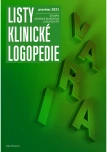TELEREHABILITATION: CURRENT DEVELOPMENT IN THE CZECH REPUBLIC
Authors:
Pětioký Jakub 1; Hoidekrová Kristýna 2; Trtílková Markéta 3
Published in the journal:
Listy klinické logopedie 2021; 5(2): 44-49
Category:
Varia
Summary
In some countries, telerehabilitation has been a common part of healthcare for several years. In the Czech Republic, telerehabilitation became known to the professional public in connection with the COVID-19 pandemic, when there was also an acute need to provide care in the field of clinical Speech Therapy. In the last two years, the rapid development of telerehabilitation also carries the risks associated with the use of methods that do not meet the requirements for cyber security and general data protection regulations. This article deals with the clarification of the terms “telehealth”, “telemedicine”, “telerehabilitation” and their forms. The article informs clinicians about the global need to develop telerehabilitation guidelines, the legislative requirements for cyber security, patient personal data protection and the technical advances in telerehabilitation in the Czech Republic, as well as future trends.
Keywords:
telerehabilitation – distance therapy – telehealth – store and forward – video conference platform
Zdroje
- ALBERTA COLLEGE OF SPEECH-LANGUAGE PATHOLOGISTSAND AUDIOLOGISTS (ACSLPA), 2019. Telepractice [online]. Edmonton: Alberta College of Speech-Language Pathologistsand Audiologists [cit. 3. 11. 2021]. Dostupné z: https://www.acslpa.ca/ wp-content/uploads/2019/05/Telepractice.pdf
- AMERICAN SPEECH-LANGUAGE-HEARING ASSOCIATION, 2021. Telepractice services and coronavirus/COVID-19 [online]. Rockville, Maryland: American Speech-Language-Hearing Association [cit. 28. 9. 2021]. Dostupné z: https://www.asha.org/practice/ telepractice-services-and-coronavirus/
- AMERICAN SPEECH-LANGUAGE-HEARING ASSOCIATION, 2016. Code of ethics [online]. Rockville, Maryland: American Speech-Language-Hearing Association [cit. 28. 9. 2021]. Dostupné z: https://www.asha.org/policy/et2016-00342/
- CASON, J.; COHN, E. R., 2014. Telepractice: An overview and best practices. Perspectives on Augmentative and Alternative Communication. 23(1), s. 4-17.
- DARKINS, A. et al., 2000. Telemedicine and telehealth: principles, policies, performances and pitfalls. New York: Springer publishing company. ISBN 9780826113023.
- WASHINGTON STATE DEPARTMENT OF HEALTH, 2018. Telepractice guidelines [online]. Tumwater, Washington: Washington State Department of Health [cit. 28. 9. 2021]. Dostupné z: https://www.doh.wa.gov/Portals/1/Documents/2300/2018/TelepracticeGuidelines.pdf
- FRIDLER, N. et al., 2012. Tele-rehabilitation therapy vs. face-to-face therapy for aphasic patients. In: eTELEMED 2012: The Fourth International Conference on eHealth, Telemedicine, and Social Medicine. Valencia: IARIA. s. 18-23.
- HARPER, D. C., 2003. Telehealth. In M. C. Roberts (Ed.), Handbook of pediatric psychology. The Guilford Press, s. 735-746.
- HOLUBOVÁ, A. et al., 2018. Využití digitálních technologií v terapii pacientů po cévní mozkové příhodě. Listy klinické logopedie. 2(2), s. 32-36.
- HOIDEKROVÁ, K. et al., 2021. Možnosti využití distanční terapie a telerehabilitace v ergoterapii u pacientů po získaném poškození mozku-pilotní studie. Rehabilitace a fyzikální lékařství, 28(1), s. 25-31.
- INDIAN SPEECH-LANGUAGE-HEARING ASSOCIATION (ISHA), 2020. Telepractice guidelines [online]. Maisúr, Indie: ISHA [cit. 3. 11. 2021]. Dostupné z: https://www.ishaindia.org.in/downloads/TELEPRACTICE-GUIDELINES.pdf
- JACOBS, K.; CASON, J.; MCCULLOUGH, A., 2015. The process for the formulation of the international telehealth position statement for occupational therapy. International Journal of Telerehabilitation. 7(1), s. 21-32.
- KURLAND, J.; LIU, A.; STOKES, P., 2018. Effects of a tablet-based home practice program with telepractice on treatment outcomes in chronic aphasia. Journal of Speech, Language, and Hearing Research. 61(5), s. 1140-1156.
- LEOCHICO, C. F. D. et al., 2020. Challenges to the emergence of telerehabilitation in a developing country: a systematic review. Frontiers in neurology. 11, s. 1007.
- KRALJEVIĆ, J. K. ; MATIĆ, A.; DOKOZA, K. P., 2020. Telepractice as a reaction to the covid-19 crisis: Insights from Croatian SLP settings. International journal of telerehabilitation. 12(2), s. 93.
- NÁRODNÍ ÚSTAV PRO KYBERNETICKOU A INFORMAČNÍ BEZPEČNOST, 2020. Bezpečnostní standard pro videokonference [online]. Brno: NÚKIB [cit. 2. 11. 2021]. Dostupné z: https://www.nukib.cz/cs/infoservis/aktuality/1599-predstavujeme-bezpecnostn i-standard-pro-videokonference/
- Speech Pathology Australia, 2014. Telepractice in speech pathology [online]. [cit. 3. 11. 2021]. Dostupné z: https://www.telemedecine-360.com/wp-content/uploads/2019/02/2015-SPA-0113_Position_Statement_Telepractice_in_Speech.pdf
- VELD, R. H. et al. Tele-rehabilitation needs assessment: A multi-disciplinary approach. In: eChallenges e-2010 Conference. IEEE, 2010. s. 1-13.
- WHO Global Observatory for eHealth, 2010. Telemedicine: opportunities and developments in Member States: report on the second global survey on eHealth. Ženeva: World Health Organization. ISBN 978 924 156 4144.
- WAKEFORD, L. et al., 2005 Telerehabilitation position paper. AJOT: American Journal of Occupational Therapy. 59(6), s. 656-661.
- ZATLOUKALOVÁ, M. et al., 2019. Současné možnosti telerehabilitace u pacientů s afázií. Listy klinické logopedie. 3(2), s. 8-12.
Štítky
Logopédia Praktické lekárstvo pre deti a dorastČlánok vyšiel v časopise
Listy klinické logopedie

2021 Číslo 2
- Využití hodnoticích skóre a objektivních nástrojů při léčbě astmatu
- Rizikové období v léčbě růstovým hormonem: přechod mladých pacientů k lékařům pro dospělé
- Gastroezofageální reflux a gastroezofageální refluxní onemocnění u kojenců a batolat
- I „pouhé“ doporučení znamená velkou pomoc. Nasměrujte své pacienty pod křídla Dobrých andělů
Najčítanejšie v tomto čísle
- EMOČNĚ-SOCIÁLNÍ OBTÍŽE U DĚTÍ S VÝVOJOVOU DYSFÁZIÍ
- TEST POROZUMĚNÍ VĚTÁM – ČESKÁ VERZE S NORMAMI PRO DOSPĚLOU POPULACI
- HODNOTENIE ÚROVNE POROZUMENIA U DETÍ V RANOM VEKU DO TRETIEHO ROKA
- TELEREHABILITACE: AKTUÁLNÍ VÝVOJ V ČESKÉ REPUBLICE
